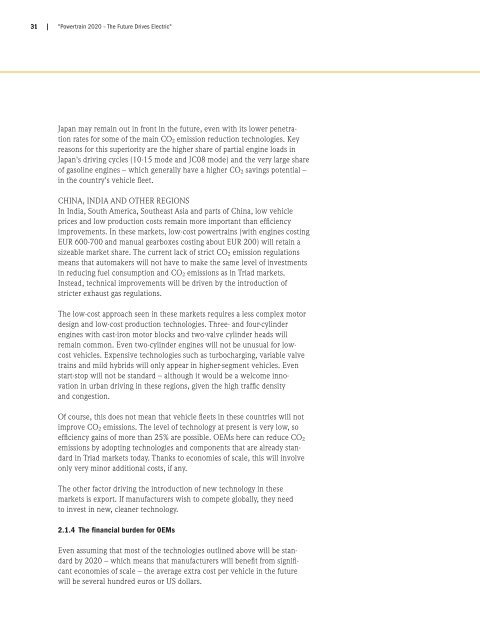Powertrain 2020 - The Future Drives Electric (PDF ... - Roland Berger
Powertrain 2020 - The Future Drives Electric (PDF ... - Roland Berger
Powertrain 2020 - The Future Drives Electric (PDF ... - Roland Berger
Create successful ePaper yourself
Turn your PDF publications into a flip-book with our unique Google optimized e-Paper software.
31 |<br />
"<strong>Powertrain</strong> <strong>2020</strong> – <strong>The</strong> <strong>Future</strong> <strong>Drives</strong> <strong>Electric</strong>"<br />
Japan may remain out in front in the future, even with its lower penetration<br />
rates for some of the main CO 2 emission reduction technologies. Key<br />
reasons for this superiority are the higher share of partial engine loads in<br />
Japan's driving cycles (10-15 mode and JC08 mode) and the very large share<br />
of gasoline engines – which generally have a higher CO 2 savings potential –<br />
in the country's vehicle fleet.<br />
CHINA, INDIA AND OTHER REGIONS<br />
In India, South America, Southeast Asia and parts of China, low vehicle<br />
prices and low production costs remain more important than efficiency<br />
improvements. In these markets, low-cost powertrains (with engines costing<br />
EUR 600-700 and manual gearboxes costing about EUR 200) will retain a<br />
sizeable market share. <strong>The</strong> current lack of strict CO 2 emission regulations<br />
means that automakers will not have to make the same level of investments<br />
in reducing fuel consumption and CO 2 emissions as in Triad markets.<br />
Instead, technical improvements will be driven by the introduction of<br />
stricter exhaust gas regulations.<br />
<strong>The</strong> low-cost approach seen in these markets requires a less complex motor<br />
design and low-cost production technologies. Three- and four-cylinder<br />
engines with cast-iron motor blocks and two-valve cylinder heads will<br />
remain common. Even two-cylinder engines will not be unusual for lowcost<br />
vehicles. Expensive technologies such as turbocharging, variable valve<br />
trains and mild hybrids will only appear in higher-segment vehicles. Even<br />
start-stop will not be standard – although it would be a welcome innovation<br />
in urban driving in these regions, given the high traffic density<br />
and congestion.<br />
Of course, this does not mean that vehicle fleets in these countries will not<br />
improve CO 2 emissions. <strong>The</strong> level of technology at present is very low, so<br />
efficiency gains of more than 25% are possible. OEMs here can reduce CO 2<br />
emissions by adopting technologies and components that are already standard<br />
in Triad markets today. Thanks to economies of scale, this will involve<br />
only very minor additional costs, if any.<br />
<strong>The</strong> other factor driving the introduction of new technology in these<br />
markets is export. If manufacturers wish to compete globally, they need<br />
to invest in new, cleaner technology.<br />
2.1.4 <strong>The</strong> financial burden for OEMs<br />
Even assuming that most of the technologies outlined above will be standard<br />
by <strong>2020</strong> – which means that manufacturers will benefit from significant<br />
economies of scale – the average extra cost per vehicle in the future<br />
will be several hundred euros or US dollars.

















